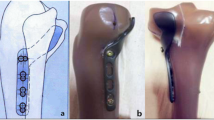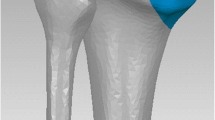Abstract
Purpose
To gain principal insight into fixation techniques of a posteromedial split fragment in bicondylar tibial plateau fractures.
Methods
A computer simulation was performed, applying the finite-element method (FEM) to compare four methods of fixation of the posteromedial split fragment: lateral plate (model 1), lateral plate and kickstand screw (model 2), lateral plate and two antero-posterior lag screws (model 3), and lateral and posteromedial plate (model 4). The displacement of the fragment and material stresses in implants and bone under 2500 N axial load were analyzed.
Results
Maximal displacement of the posteromedial split fragment of 2.8 mm was found with a sole lateral plate. An added kickstand screw decreased the displacement to 1.46 mm. Added lag screws improved stability by a factor 4, with a maximal displacement of 0.76 mm. The double-plate configuration revealed 0.27 mm, a decrease of the displacement by a factor 10 compared to model 1. An additional analysis of posteromedial fragment displacements with osteoporotic bone, simulated by dividing the elastic modulus of the bone by a factor 2, turned out to be of relevant impact. For model 1, the calculations did not converge. The influence of bone quality was found to be 70% in model 2, 60% in model 3, and 40% in model 4.
Conclusions
The results indicate that the additional fixation of a posteromedial split fracture by plate osteosynthesis might be advantageous in bicondylar tibial plateau fractures treated with lateral plating. This might be even more important in patients with low bone quality.








Similar content being viewed by others
References
McNamara IR, et al. Surgical fixation methods for tibial plateau fractures. Cochrane database Syst Rev. 2015;9:009679.
Lee T-C, Huang H-T, Lin Y-C, Chen C-H, Cheng Y-M, Chen J-C. Bicondylar tibial plateau fracture treated by open reduction and fixation with unilateral locked plating. Kaohsiung J Med Sci. 2013;29(10):568–77.
Lee AK, Cooper SA, Collinge C. Bicondylar tibial plateau fractures. JBJS Rev. 2018;6(2):e4.
McGonagle L, Cordier T, Link BC, Rickman MS, Solomon LB. Tibia plateau fracture mapping and its influence on fracture fixation. J OrthopTraumatol. 2019;20(1):12.
Barei DP, Mara TJ, Taitsman LA, Dunbar RP, Nork SE. Frequency and fracture morphology of the posteromedial fragment in bicondylar tibial plateau fracture patterns. J Orthop Trauma. 2008;8:9.
Hake ME, Goulet JA. Open reduction and internal fixation of the posteromedial tibial plateau via the lobenhoffer approach. J Orthop Trauma. 2016;30(Suppl 2):S35–6.
Samsami S, Pätzold R, Winkler M, Herrmann S, Augat P. The effect of coronal splits on the structural stability of bi-condylar tibial plateau fractures: a biomechanical investigation. Arch Orthop Trauma Surg. 2020;2:8.
Hua K, Jiang X, Zha Y, Chen C, Zhang B, Mao Y. Retrospective analysis of 514 cases of tibial plateau fractures based on morphology and injury mechanism. J Orthop Surg Res. 2019;14(1):267.
Chen H-W, Chen C-Q, Yi X-H. Posterior tibial plateau fracture: a new treatment-oriented classification and surgical management. Int J ClinExp Med. 2015;8(1):472–9.
Eggli S, Hartel MJ, Kohl S, Haupt U, Exadaktylos AK, Röder C. Unstable bicondylar tibial plateau fractures: a clinical investigation. J Orthop Trauma. 2008;22(10):673–9.
Pätzold R, Friederichs J, von Rüden C, Panzer S, Bühren V, Augat P. The pivotal role of the coronal fracture line for a new three-dimensional CT-based fracture classification of bicondylar proximal tibial fractures. Injury. 2017;48(10):2214–20.
Boeck HOP. Posteromedial tibial plateau fractures. Operative treatment by posterior approach. ClinOrthopRelat Res. 1995;320:125–8.
Georgiadis GM. Combined anterior and posterior approaches for complex tibial plateau fractures. J Bone Joint Surg Br. 1994;76(2):285–9.
Zeng ZM, Luo CF, Putnis S, Zeng BF. Biomechanical analysis of posteromedial tibial plateau split fracture fixation. Knee. 2011a;2:14.
Yoo BJ, Beingessner DM, Barei DP. Stabilization of the posteromedial fragment in bicondylar tibial plateau fractures: a mechanical comparison of locking and nonlocking single and dual plating methods. J Trauma Inj Infect Crit Care. 2010;69(1):148–55.
Horwitz DS, Bachus KN, Craig MA, Peters CL. A biomechanical analysis of internal fixation of complex tibial plateau fractures. J Orthop Trauma. 1999;13(8):545–9.
Koh Y-G, Son J, Kwon SK, Kim HJ, Kang K-T. Biomechanical evaluation of opening-wedge high tibial osteotomy with composite materials using finite-element analysis. Knee. 2018;25(6):977–87.
Luo C-A, Hwa S-Y, Lin S-C, Chen C-M, Tseng C-S. Placement-induced effects on high tibial osteotomized construct - biomechanical tests and finite-element analyses. BMC MusculoskeletDisord. 2015;16(1):235.
Lasanianos NG, Garnavos C, Magnisalis E, Kourkoulis S, Babis GC. A comparative biomechanical study for complex tibial plateau fractures: nailing and compression bolts versus modern and traditional plating. Injury. 2013;44(10):1333–9.
Koh Y-G, Lee J-A, Lee H-Y, Chun H-J, Kim H-J, Kang K-T. Design optimization of high tibial osteotomy plates using finite element analysis for improved biomechanical effect. J OrthopSurg Res. 2019;14(1):219.
Chen Y-N, et al. Biomechanical investigation of the type and configuration of screws used in high tibial osteotomy with titanium locking plate and screw fixation. J OrthopSurg Res. 2019;14(1):35.
Wolfram U, Schwiedrzik J. Post-yield and failure properties of cortical bone. Bonekey Rep. 2016;5:7.
Little RB, Wevers HW, Siu D, Cooke TDV. A three-dimensional finite element analysis of the upper tibia. J BiomechEng. 1986;108(2):111–9.
Chang C-W, et al. Biomechanical investigation of tibial tubercle osteotomy fixed with various screw configurations. Injury. 2019;50(2):263–71.
Huang X, Zhi Z, Yu B, Chen F. Stress and stability of plate-screw fixation and screw fixation in the treatment of Schatzker type IV medial tibial plateau fracture: a comparative finite element study. J OrthopSurg Res. 2015;10(1):182.
Ren D, Liu Y, Zhou B, Lu J, Wang P. A novel design of a plate for posterolateral tibial plateau fractures based on computed tomography mapping of the proximal tibiofibular joint. Med Sci Monit. 2018;24:9300–6.
Homminga J, Mccreadie BR, Weinans H, Huiskes R. The dependence of the elastic properties of osteoporotic cancellous bone on volume fraction and fabric. J Biomech. 2003;36(10):1461–7.
Mistry K, Bhoil R, Sood D, Suthar P. Calculation of the reference bone mineral density values in North Indian population using phantomless quantitative computed tomography. J Orthop Allied Sci. 2018;6(1):33.
Higgins TF, Kemper D, Klatt J. Incidence and morphology of the posteromedial fragment in bicondylar tibial plateau fractures. J Orthop Trauma. 2009;3:9.
Cuéllar VG, Martinez D, Immerman I, Oh C, Walker PS, Egol KA. A biomechanical study of posteromedial tibial plateau fracture stability. J Orthop Trauma. 2015;29(7):325–30.
Weaver MJ, et al. Fracture pattern and fixation type related to loss of reduction in bicondylar tibial plateau fractures. Injury. 2012;43(6):864–9.
Zeng Z-M, Luo C-F, Putnis S, Zeng B-F. Biomechanical analysis of posteromedial tibial plateau split fracture fixation. Knee. 2011b;18(1):51–4.
www.sawbones.com/biomechanical-product-info, “Biomechanical Materials for Precise, Repeatable Testing,” 2018. .
Golovakha ML, et al. Comparison of theoretical fixation stability of three devices employed in medial opening wedge high tibial osteotomy: a finite element analysis. BMC MusculoskeletDisord. 2014;15(1):230.
Yildirim G, Walker PS, Sussman-Fort J, Aggarwal G, White B, Klein GR. The contact locations in the knee during high flexion. Knee. 2007;14(5):379–84.
Kutzner I, et al. Loading of the knee joint during activities of daily living measured in vivo in five subjects. J Biomech. 2010;43(11):2164–73.
Gösling T, Schandelmaier P, Marti A, Hufner T, Partenheimer A, Krettek C. Less invasive stabilization of complex tibial plateau fractures. J Orthop Trauma. 2004;18(8):546–51.
Beitz K-H. Wolfgang. DUBBEL - Taschenbuchfür den Maschinenbau: Küttner; 1995.
Author information
Authors and Affiliations
Corresponding author
Ethics declarations
Conflict of interest
Karl-Heinz Frosch received grants and fees for research and teaching activities from Arthrex, Inc. (Naples, USA).
Rights and permissions
About this article
Cite this article
Dehoust, J., Münch, M., Seide, K. et al. Biomechanical aspects of the posteromedial split in bicondylar tibial plateau fractures—a finite-element investigation. Eur J Trauma Emerg Surg 46, 1257–1266 (2020). https://doi.org/10.1007/s00068-020-01538-3
Received:
Accepted:
Published:
Issue Date:
DOI: https://doi.org/10.1007/s00068-020-01538-3




